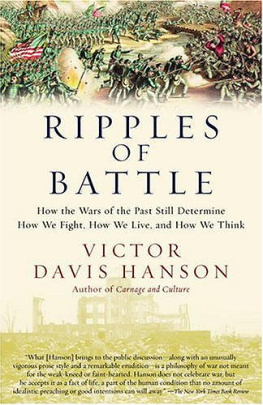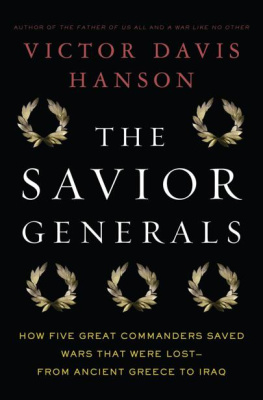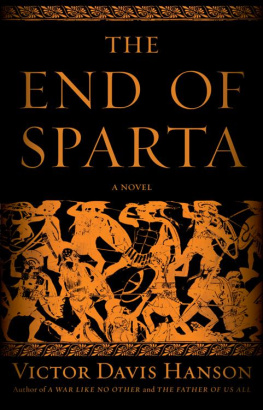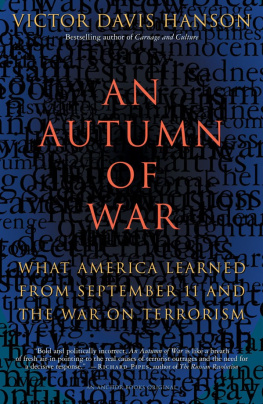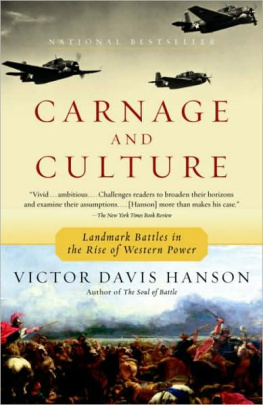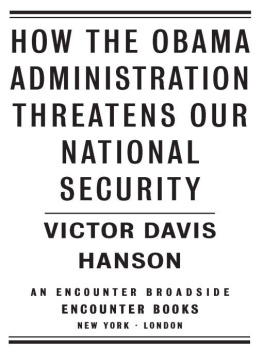Victor Davis Hanson - Ripples of Battle
Here you can read online Victor Davis Hanson - Ripples of Battle full text of the book (entire story) in english for free. Download pdf and epub, get meaning, cover and reviews about this ebook. year: 2004, publisher: Knopf, genre: Politics. Description of the work, (preface) as well as reviews are available. Best literature library LitArk.com created for fans of good reading and offers a wide selection of genres:
Romance novel
Science fiction
Adventure
Detective
Science
History
Home and family
Prose
Art
Politics
Computer
Non-fiction
Religion
Business
Children
Humor
Choose a favorite category and find really read worthwhile books. Enjoy immersion in the world of imagination, feel the emotions of the characters or learn something new for yourself, make an fascinating discovery.
- Book:Ripples of Battle
- Author:
- Publisher:Knopf
- Genre:
- Year:2004
- Rating:3 / 5
- Favourites:Add to favourites
- Your mark:
- 60
- 1
- 2
- 3
- 4
- 5
Ripples of Battle: summary, description and annotation
We offer to read an annotation, description, summary or preface (depends on what the author of the book "Ripples of Battle" wrote himself). If you haven't found the necessary information about the book — write in the comments, we will try to find it.
Ripples of Battle — read online for free the complete book (whole text) full work
Below is the text of the book, divided by pages. System saving the place of the last page read, allows you to conveniently read the book "Ripples of Battle" online for free, without having to search again every time where you left off. Put a bookmark, and you can go to the page where you finished reading at any time.
Font size:
Interval:
Bookmark:
Acknowledgments
Secondary literature is discussed in the following brief bibliographical essay, with page numbers cited for direct quotations in the text. I would like to thank veterans of F Company, 2nd Battalion, 29th Regiment, 6th Marine Division, for their letters, phone calls, photographs, and notes concerning Victor Hansonespecially Richard Whitaker, Robert Sherer, William Twigger, Louis Ittmann, Michael Senko, Edward Hewlik, and others. Some fifty-seven years after Victor Hanson perished on Okinawa, I finally know how he died, have his pictures from the war, and his ring, all thanks to the generosity of these brave veterans.
Classics students at California State UniversityFresno, Kristi Hill and Sabina Robinson, helped with selection and acquisition of the photographs, as well as typing and proofreading duties. Rebecca and Raymond Ibrahim and Ray Sanchez aided with bibliographical tasks. Katherine Becker, a doctoral student in military history at Ohio State University, made available a great number of sources not otherwise available here at CSU Fresno and read the manuscript. My colleague in Classics, Professor Bruce Thornton, offered invaluable insight about the organization of the book and critiqued the text at its penultimate stage. Professor M. C. Drake once again drew the maps and the rendition of the warrior grave of Saugenes.
My wife Cara read the entire manuscript and helped in efforts to locate members of F Company from the 29th Marinesand took up many of my obligations on our farm that I often was obliged to neglect these past three years. My literary representatives of a decade, Glen Hartley and Lynn Chu, gave invaluable advice throughout preparation of the manuscript as both agents and friends. I thank once again my editor of a decade, Adam Bellow, at Doubleday, for continued confidence and support.
ALSO BY VICTOR DAVIS HANSON
Warfare and Agriculture in Classical Greece
The Western Way of War:
Infantry Battle in Classical Greece
Hoplites: The Ancient Greek Battle Experience (editor)
The Other Greeks: The Agrarian Roots
of Western Civilization
Fields Without Dreams: Defending the Agrarian Idea
Who Killed Homer? The Demise of Classical Education and the
Recovery of Greek Wisdom (with John Heath)
The Wars of the Ancient Greeks
The Soul of Battle: From Ancient Times to the Present Day,
How Three Great Liberators Vanquished Tyranny
The Land Was Everything: Letters from an American Farmer
Bonfire of the Humanities (with John Heath and Bruce Thornton)
Carnage and Culture: Landmark Battles
in the Rise of Western Power
An Autumn of War
Mexifornia: On a State of Becoming
Bibliography
1. The Wages of Suicide
Recipe for a Holocaust
There are especially fine official histories of Okinawa, written by prominent American historians. See first R. Appleman, J. M. Burns, R. A. Gugeler, and J. Stevens, Okinawa: The Last Battle (Rutland, Vt., and Tokyo, 1960). Its appendices contain most of the statistics on troops committed and lost at the battle; cf. 32223 for accounts of the 29th Marines on Sugar Loaf Hill; 58 for the Japanese suicides; and 47374 for final judgments.
See also the official history of the U.S. Marine Corps on Okinawa, by C. S. Nichols and H. I. Shaw, Okinawa: Victory in the Pacific (Washington, D.C., 1955), 18083 for Company F on Sugar Loaf Hill and its environs. And cf. especially P. Carleton, The Conquest of Okinawa: An Account of the Sixth Marine Division (Washington, D.C., 1947); and K. Stockman, The Sixth Marine Division on Okinawa (Washington, D.C., 1946).
An interesting account of the Japanese defenses on Okinawa is offered by Col. Hiromichi Yahara, who was in great part responsible for the effective tactics of attrition and rugged defense rather than open counterassaults: H. Yahara, The Battle for Okinawa (translated by R. Pineau and M. Uehara), New York, 1995; cf. 143 for his thoughts of the suicide of Japanese soldiers, and 200 for Frank Gibneys appraisals of the civilian suicides.
For Okinawa as The England of the Pacific, see J. H. Alexander, The Final Campaign: Marines in the Victory on Okinawa (Washington, D.C., 1996), 2; and cf. 33 for the suicides at the Asa River. See also B. M. Frank, Okinawa: Capstone to Victory (New York, 1970), 2021 for a discussion of the nature of the Japanese defenses; and T. M. Huber, Japans Battle of Okinawa, AprilJune 1945 (Leavenworth, Kans., 1990), 38, 65 for Japanese impressions of the nearly impassable terrain on the island, and the Americans lack of imagination in circumventing the Japanese defenses. In general, there are revealing oral histories in G. Astor, Operation Iceberg: The Invasion and Conquest of Okinawa in World War II (New York, 1995).
Divine Wind
On the ideology of the Japanese suicide bombers, see R. Leckie, Okinawa: The Last Battle of World War II (New York, 1995). For the skill of American sailors in fighting the kamikazes, and their attitude about the use of suicide bombers, see too, A. Lott, Brave Ship, Brave Men (Annapolis, Md., 1986), especially 16474.
There is a growing literature on the kamikazes, both American accounts and memoirs of Japanese veterans who survived the squadrons; oddly, American rather than Japanese histories are more apt to praise the bravery, rather than condemn the fanaticism, of the pilots. For a narrative of the special squadrons of both kamikaze and Okha pilots from the Japanese perspective, see H. Naito, Thunder Gods: The Kamikaze Pilots Tell Their Story (New York, 1989). For Tojos code of ethics, see 20; and for dissension and fright among the suicide ranks, 96, 209.
See also E. Hoyt, The Kamikazes (New York, 1983); B. Millot, Divine Thunder: The Life and Death of the Kamikazes (New York, 1971), especially 22931 for the letter of Teruo Yamaguchi. The origins of the kamikazes are discussed in depth by J. Field, The Japanese at Leyte Gulf: The Sho Operation (Princeton, 1947), and R. Inoguchi and T. Nakajima, The Divine Wind: Japans Kamikaze Force in World War II (Westport, Conn., 1959). For their remarks on the unique nature of the suicide corps, see xxi; Ensign Heiichi Okabes letter is found at 190.
R. Spurr, A Glorious Way to Die (New York, 1981), has a detailed account of the last voyage of the Yamato. Westerners, who did not embrace suicide, could write in starry-eyed tributes, Japanese heroes gave the world a great lesson in purity. From the depth of their ancient past they brought a forgotten message of human grandeur (Millot, Divine Thunder, 233). For the civilian experience, see R. Keyso, Women of Okinawa (Ithaca, N.Y., 2000); for the accounts of Junkyo Isa, cf. 67, 1112.
The Military Lessons
For Churchills quote and other assessments of Okinawas importance, see I. Gow, Okinawa 1945: Gateway to Japan (New York, 1985), 21315. George Feifers Tennozan: The Battle of Okinawa and the Atomic Bomb (New York, 1992) has an incisive analysis of the connection between Okinawa and Hiroshima; cf. 58384; for the remarks of Thomas Hannaher, cf. 544. See also P. Fussell, Thank God for the Atomic Bomb and Other Essays (New York, 1988), who points out that those who were removed from the frontline fightingin both time and spacewere most likely to oppose use of the bomb; in contrast, the relieved veterans of the Pacific fighting knew the carnage that lay ahead on the Japanese mainland.
Epilogue: The Men of Okinawa
For details about Ernie Pyles death and his writing during the war, see J. Tobin,
Next pageFont size:
Interval:
Bookmark:
Similar books «Ripples of Battle»
Look at similar books to Ripples of Battle. We have selected literature similar in name and meaning in the hope of providing readers with more options to find new, interesting, not yet read works.
Discussion, reviews of the book Ripples of Battle and just readers' own opinions. Leave your comments, write what you think about the work, its meaning or the main characters. Specify what exactly you liked and what you didn't like, and why you think so.

